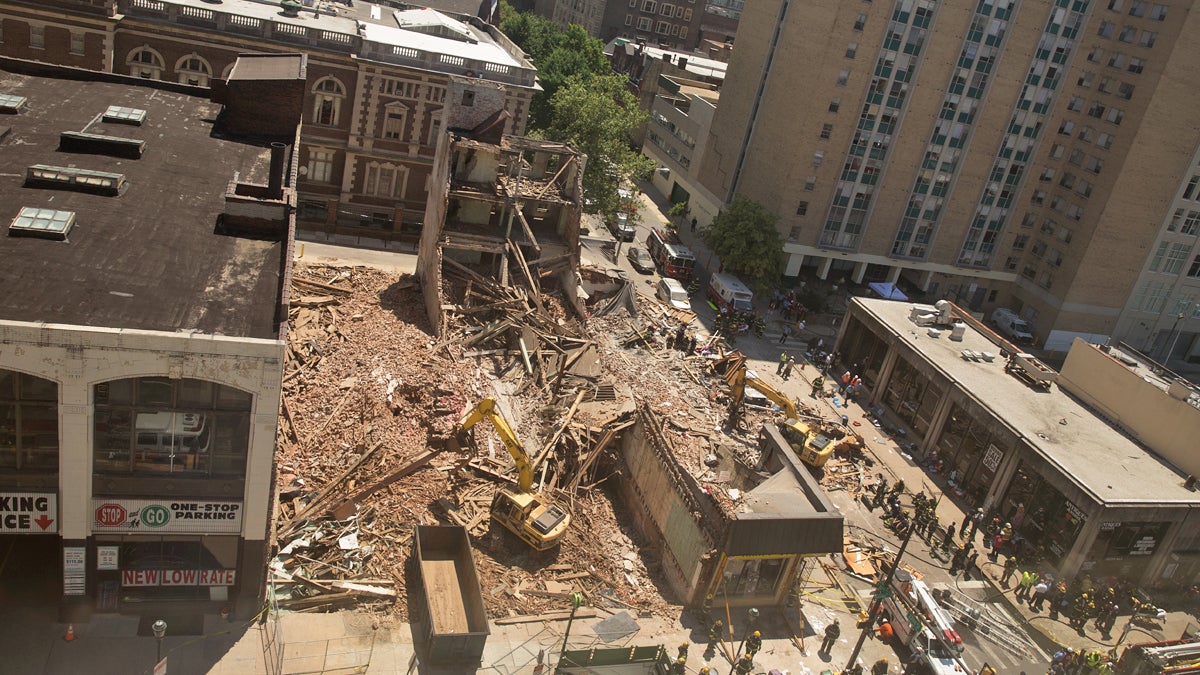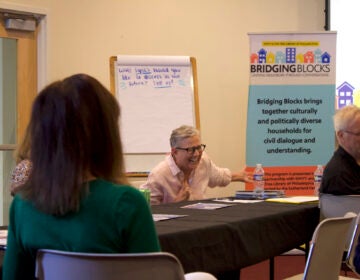Demolition contractor faces murder charges in Philadelphia building collapse
Listen
Rescue personnel search the rubble of a building that collapsed at the corner of Market and 22nd streets in Center City Philadelphia on June 5, 2013. Philadelphia District Attorney Seth Williams on Monday said that contractor Griffin T. Campbell has been charged with third-degree murder, as well as manslaughter, in connection with the collapse. (Lindsay Lazarski/WHYY)
The demolition contractor involved in this summer’s deadly building collapse in downtown Philadelphia has been charged with third-degree murder.
District Attorney Seth Williams announced Monday that contractor Griffin T. Campbell is facing six counts of third-degree murder, as well as six counts of involuntary manslaughter, 13 counts of reckless endangerment, criminal conspiracy and other related charges in connection to the collapse.
On June 5, a wall of the property that was being demolished by Campbell’s team fell onto the Salvation Army thrift store next door. The building collapse left six people dead and injured 13.
As Williams tells it, Campbell routinely faced a choice while tearing down the property. He could maximize his profits or ensure the safety of human beings. Again and again, the district attorney said, Campbell went with profits.
“Bluntly, the motive is greed,” said Williams.
Williams said the building should have been taken down “by hand, piece by piece, brick by brick, floor by floor. But that demolition method is expensive and very time-consuming.”
Instead, Williams said that a piece of heavy equipment operated by Kary Roberts, aka Sean Benschop, was used in the demolition.
Campbell also told his employees to tear down the building from the inside out, Williams said, rather than from the top down, as is recommended. This was done because Campbell wanted to take out wooden joists that he could re-sell for about $6 to $8 each, according to the investigating grand jury presentment. (See the presentment below.)
Despite the improper demolition methods, Williams said the tragedy might have been avoided if Campbell had installed scaffolding to prop up the building’s exterior walls. Campbell told architect Plato Marinakos that he was going to erect scaffolding, as well as take down the western wall by hand, according to the presentment.
“In reality, however, Campbell was unwilling to pay for enough labor to perform the necessary task,” said Williams. “On the morning of Wed., June 5, most of the west wall still loomed over the job site and the Salvation Army building.”
William Hobson, Campbell’s attorney, insists that the demolition contractor did not put profits over people.
“Nothing could be further from the truth,” said Hobson. “My client exercised safe standards, removing the building brick by brick. And my client repeatedly sought the cooperation from Salvation Army and was denied access to the roof of their building to install any safety devices.”
DV.load(“//www.documentcloud.org/documents/841587-market-street-collapse-grand-jury-presentment.js”, {
width: 600,
height: 800,
sidebar: false,
text: false,
container: “#DV-viewer-841587-market-street-collapse-grand-jury-presentment”
});
Market Street Collapse Grand Jury Presentment (PDF)
Market Street Collapse Grand Jury Presentment (Text)
Investigation is continuing
Williams also announced an additional charge of criminal conspiracy against Benschop. He was previously charged with involuntary manslaughter and risking a catastrophe.
Benschop’s attorney, Daine Grey, said that the equipment operator is being unfairly blamed for the tragedy.
“We believe that he is the ultimate scapegoat,” said Grey. “He did nothing wrong and we will prove that on our day in court.”
Attorney Robert Mongeluzzi, who represents several people injured in the collapse as well as families of some of those who were killed, said he hopes the investigating grand jury will come back with additional indictments. He said documents show that Richard Basciano, who owned the building, also played a role in the tragedy.
“Safety starts at the top, and this was an imminently dangerous situation which continued for days on end,” he said. “The emails released to date implicate the owner as pressuring Griffin Campbell and as being part of this process.”
Williams said, repeatedly, that the charges against Campbell do not mark the end of the grand jury’s investigation into the deadly building collapse.
WHYY is your source for fact-based, in-depth journalism and information. As a nonprofit organization, we rely on financial support from readers like you. Please give today.




